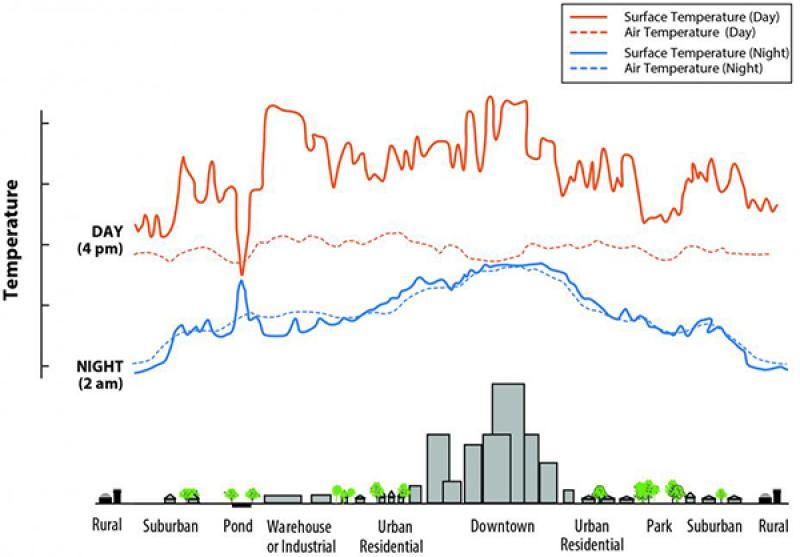It's hot in the city: Understanding the urban heat island effect on Ohio State's campus

Forty years ago, Ohio State geography Professor John Arnfield would get into his Volkswagen Microbus and set out to study the microclimates in Columbus. His wife, Joan, marked intersections in the city as sensors mounted on top of the vehicle and a strip chart recorder kept track of the decreasing temperature from the urban settings of campus and downtown toward Scioto Downs, a horseracing track in a rural area south of the city.
The temperature was lower in the rural areas because of the urban heat island effect, which results from factors including activity in the city, buildings and roads and their materials, and lack of green infrastructure.
Now, Jim DeGrand, a senior researcher in geography and assistant state climatologist, and colleagues from Byrd Polar and Climate Research Center; university Planning, Architecture and Real Estate; and the Sustainability Institute at Ohio State are determining what the urban heat island effect means for Ohio State. By classifying climate zones at the Columbus campus and installing a sensor network to monitor and measure the heat island effect, the team expects to explore ways to reduce its impact.
“This effect, while it isn’t often the first thing that people think about in the context of the urban heat island,” says DeGrand, “is significant for human comfort and health — think about how cities remain quite warm in the evenings during heat waves — and also for energy consumption since large daily temperature ranges place higher demands on building HVAC services.”

Human comfort and health factor into quality of life, a category for improvement measured in the university’s sustainability goals. Data related to the urban heat island effect will feed into metrics in Ohio State’s unique Ecosystem Services Index, which defines categories for campus improvement toward the goal of increasing campus ecosystem services, benefits that society receives from the natural environment, by 60 percentage points by 2025.
Under certain conditions — say, a day with calm winds and relatively clear skies — those actual temperatures can differ more than you might think across relatively small distances. Consider the intersection of Broad and High streets in downtown Columbus versus the rural Madison County line 13 miles west of the city. Take a guess at the temperature span. Two degrees Farenheit? Three? Maybe even 5?
Try 14. That’s what DeGrand and his students found in 2012 when they conducted a study similar to Arnfield’s but with more modern tools — an electronic datalogger and a GPS tracker.
“That’s a massive, massive difference,” says DeGrand, adding that although the temperature variation isn’t normally quite that pronounced, Columbus is often among the U.S. cities that have the largest daytime urban heat island effect.
Using Campus as a Lab
In addition to supporting progress toward the university’s ecosystem services goal, the project provides a living lab opportunity for students. DeGrand is incorporating the data collection, analysis and presentation aspects into his Microclimatological Measurements course in the Department of Geography.
He also recruited Randall Jones, an atmospheric science major, to help find good locations for the sensors.

“Since the urban heat island can have devastating effects to humans (such as heat-related illnesses) as well as the surrounding environment (for example, rainwater temperatures that have come in contact with extremely hot rooftops or pavement surfaces can reach over 90 degrees, which eventually makes its way into lakes and rivers and affects aquatic life), I think it is important to do more research in these areas,” Jones says. “It would be very beneficial to the overall health of the planet to figure out more potential impacts of the urban heat island and to attempt to limit the damaging impact it is causing.”
Jones graduated in spring 2020 and will pursue a master’s degree in atmospheric science at the University of Washington. He plans to pursue a doctorate degree and become a professor. He wants to research impact of hurricanes on different areas of the world because of climate change.
“Prior to working on this project, as well as one of the classes that was a part of the atmospheric science curriculum, I didn’t really know anything about the urban heat island effect,” says Jones, “so when I learned of it, I was somewhat surprised by the magnitude of the effects that the heat island could have on different areas of the weather. As part of my research with the project, I learned of some cities that are implementing projects to help mitigate the urban heat island effect, which I found very reassuring.”
Monitoring the Temperature — and More
Jones helped install the university’s first urban heat island sensor station on West Campus. The team plans to have up to 10 more before the end of the year — in the College of Food, Agricultural and Environmental Sciences area; near the Wexner Medical Center; in the core academic area north of the Oval; and on Waterman Farm. The project is supported by the Ohio State Sustainability Fund, approved by the President and Provost’s Council on Sustainability.
“Each station has sensors to measure air temperature, relative humidity, vapor pressure, barometric pressure, wind (speed, gust and direction), solar radiation, precipitation and lightning strikes (count and distance),” explains Jason Cervenec, education and outreach director for Byrd Polar and Climate Research Center. “Each station runs on very little power provided by a solar panel.”
Recent technological advancements opened doors to more economical research in this area.
“These sensors didn’t exist at this cost point until recently,” Cervenec says. “Even five years ago, you couldn’t take all this out of the box and network it.”
Researchers have been looking at the urban heat island phenomenon for decades, DeGrand says.
“In all that time, people talked about the differences in temperature between urban and rural areas, but they never defined what urban and rural was,” he says. “They can be forgiven because it’s difficult. If we go out on the Oval, is it urban? In some senses it is, but in some senses it’s not.”
A solution came in 2012, when Tim Oke, who DeGrand calls “a legend in microclimate,” and colleagues developed a classification system of 17 climate zones with varying aspects of urban and rural characteristics. The system developed by Oke, geography professor emeritus at the University of British Columbia, enables scientists to better understand the causes and effects of urban heat islands and to develop solutions.
“Our campus is remarkable in that within the main campus, we have some rural climate zones, like Waterman Farm, and some areas, such as near the hospital, that are close to the most urban zones,” DeGrand says.
Graduate student Young Jaegal, a geography student graduating this summer, worked with campus GIS information and university Planning, Architecture and Real Estate to develop a comprehensive database of the climate zones for the entire Columbus campus. The results are guiding decisions about placing the sensor stations at sites representative of various conditions throughout campus.
What’s next
The campus urban heat island effect monitoring serves as a short-term goal; the team will use the results to determine how laborious such a project would be for a city and whether they can find applications on a statewide level to support the work of the State Climate Office of Ohio, a partnership between the university’s Department of Geography, Byrd Polar and Ohio State University Extension.
“We do work with the Mid-Ohio Regional Planning Commission on climate-related issues,” Cervenec says. “For example, there’s an air quality and heat nexus where higher temperatures are associated with air pollution. Typically, traffic pollution decreases air quality — that’s one of the threats in Columbus with climate change.”

Understanding the urban heat island effect could inform planning and development decisions, adds Cervenec, who led a task force that developed the Columbus Climate Adaptation Plan in 2018.
“Is it possible to anticipate what certain infrastructure will do to a city’s urban heat island?” Cervenec asks. “Are you able to use that in service of future planning?”
He points out that local and federal governments set regulations to reduce infrastructure stormwater effects on the environment.
“Some cities have required or incentivized green infrastructure on roofs,” he says. “Nobody’s coupled that with saying, ‘You can’t build something because the urban heat island effect will be increased by what you’re building.’”
The team sees potential for adding other sensors, such as those for ambient light or noise, to the system once the infrastructure and a planned data hub are available.
DeGrand envisions cities using a system like Ohio State’s to monitor urban heat island effects to measure and predict health implications.
“I’m guessing places that have among the highest urban heat effects might also be places where people have less means, such as air conditioning or parks, to mitigate that,” he says. “Looking at that could help a city that’s looking to be more sustainable.”
By Joan Slattery Wall, editor, Sustainability Institute at Ohio State
